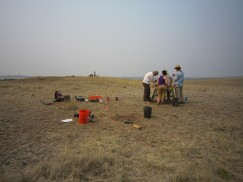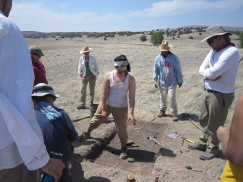- Home
- >
- Preservation Archaeology Blog
- >
- Student Post: Reading the Dirt
 |
By Deborah L. Huntley, Preservation Archaeologist
|

Kelly Sweeney and her crew are learning to “read the dirt”:
It is always exciting to start a new unit and uncover what lies beneath the soil. When I first arrived at the Fornholt site, I felt this exact sentiment. My crew’s goal was to uncover the pit edge (or wall) of a possible subterranean ceremonial structure (or kiva) in the central area of the site between the two masonry room blocks. We chose the location of our unit by a scientific method called “making an educated guess,” and then we set out to find the structure wall.
The first few days of excavation were really promising. We found large quantities of pottery sherds and flaked stone in the first couple of levels of excavating. And then we struck gold: we uncovered a sterile soil (meaning that there was no cultural material in it) in the southeast corner of our excavation unit. This was a really good sign that we would soon encounter the wall.

We eagerly uncovered the sterile soil layer throughout the rest of unit, but still, no wall. We expanded our unit north by another 2 meters, hoping to catch the edge of the pit. It quickly became apparent that the sterile soil was not behaving as we expected, and still the wall was nowhere to be found. By now, we had enough of the profile exposed to see that a rill—essentially a water channel running down a hill—had cut right through our sterile soil. This made the interpretation of the unit much more confusing, and very frustrating.
But we did what any archaeologist would do; we kept on digging to find out what was going on. Though we had a lot of moments where we were very discouraged, the amount of information we were gaining from the unit was substantial. The copious pottery sherds we’ve recovered can provide us with information on when people lived at the site, trading networks, and ceramic usage. We also uncovered flaked stones made by every type of raw material possible. And even though the rill caused us problems, it offered an important geology lessons for us new archaeologists. So, even though the dirt does not always present what you had anticipated, it yields valuable information, nevertheless.
And yes, we did eventually find the wall of the kiva, which was a thrilling moment. More on that soon.
Explore the News
-
Join Today
Keep up with the latest discoveries in southwestern archaeology. Join today, and receive Archaeology Southwest Magazine, among other member benefits.